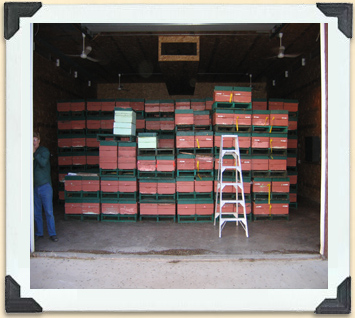The Keeper

Large warehouses can hold thousands of hive boxes full of overwintering bees.
© Agriculture and Agrifood Canada, Beaverlodge Research Station
Overwintering Techniques
It's certainly no secret that Canada can have some pretty harsh winters, and so it's really important for beekeepers to protect their colonies from the bitter cold. Bees create their own heat by clustering together inside the hive, but the beekeeper can still help them out.
In the late fall, beekeepers may choose to wrap their hives with tar paper or insulation board to keep out the cold. Or they may bring their hives indoors to a basement or to a warehouse in which temperature and humidity can be controlled, putting them back outside in early spring.






